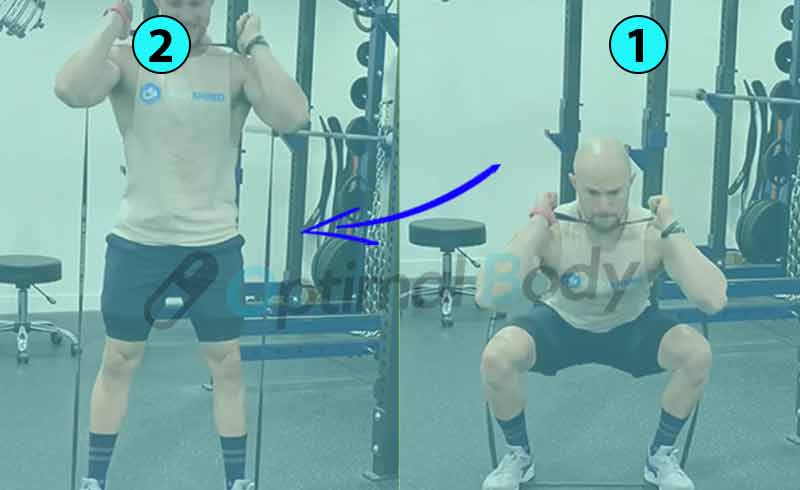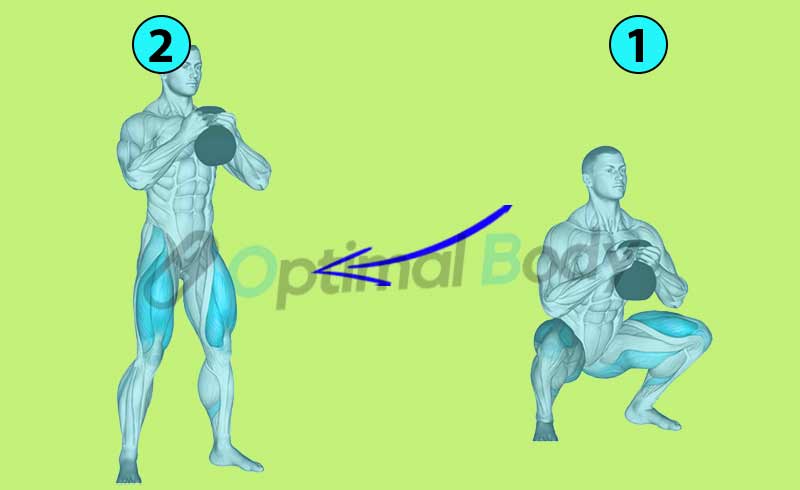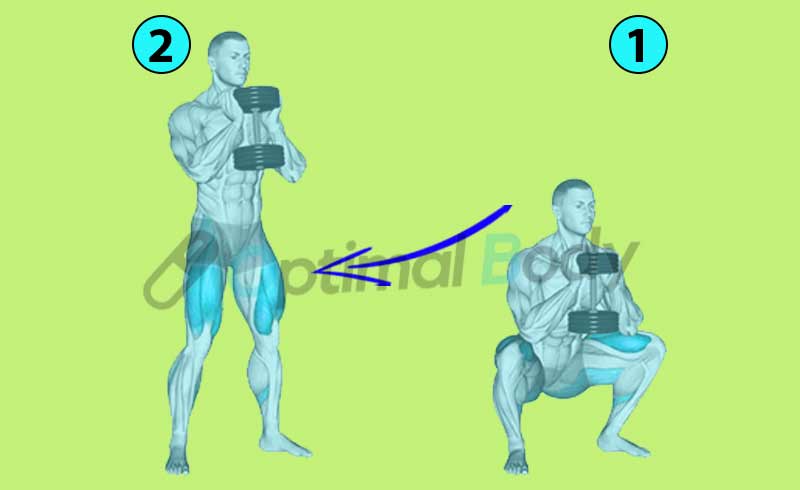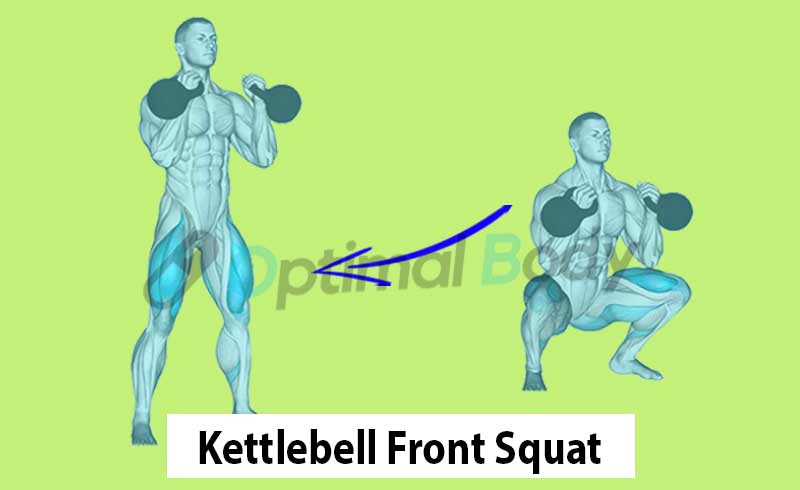The kettlebell front squat is a highly efficient exercise that targets multiple key muscles in your body. Its primary focus is on developing leg muscles and core strength, while also aiding in proper lifting posture.
Additionally, it reduces strain on your body’s mechanics and boosts overall functional fitness.
Muscles Worked during Kettlebell Front Squats:
- Gluteus Maximus: This large muscle shapes your buttocks and hips, playing a crucial role in posture and overall performance.
- Quadriceps: Comprising rectus femoris, vastus lateralis, vastus medialis, and vastus intermedialis, these upper-leg muscles are essential for movements like squatting, contributing to stronger and more defined quads
- Hamstrings: Consisting of semitendinosus, semimembranosus, and biceps femoris, these muscles at the back of the upper leg play a vital role in activities such as standing, sprinting, jumping, and stabilizing the knee joints
- Core Muscles: Engaging the abs, obliques, spinal erectors, and deep core muscles, these muscles support mid-section stability, including functions like crunching, twisting, rotating, and maintaining an upright posture.
- Calf Muscles: Including the gastrocnemius (visible below the knee) and the deeper soleus, calf muscles provide power for rapid movements (gastrocnemius) and endurance activities (soleus).
Kettlebell Front Squat Benefits
Here are some of the key benefits you can reap from including Kettlebell Front Squats in your workouts:
- Activates Dormant Buttock Muscles: The exercise engages the often underactive gluteus maximus, helping you develop a stronger and shapelier rear end.
- Improves Core Stability: Unlike the back squat, the Kettlebell Front Squat puts a premium on core strength and stabilization, promoting better posture and balance.
- Boosts Joint Health: Regularly performing this exercise pumps vital nutrients into your joints, fostering better joint health over time.
- Cardiovascular Challenge: Surprisingly, this exercise can elevate your heart rate, providing a cardio workout without the need to jump around or move your feet extensively.
How to Do the Single Kettlebell Front Squat:
- Begin with the kettlebells on the floor.
- Lift the kettlebells into the front rack position, ensuring they rest on your forearms and upper arms.
- Keep your elbows close to your ribs and positioned directly under your arms.
- Maintain a tall, neutral spine with your chest up and shoulders back.
- Start the squat by lowering your body until your upper legs are slightly below parallel to the ground.
- Stand up while holding the kettlebells in front of you, then repeat the movement as needed to complete your set.
Exercise Tips:
- Keep the elbow in, wrist straight, and kettlebell snug against your chest. Relax the shoulder.
- Don’t worry if your knees pass your toes; this helps with balance and activates the quadriceps.
- Prevent elbow winging or kettlebell drift forward to avoid shoulder fatigue and injuries.
- Sit back into your heels, keeping them on the floor. Descend until thighs are parallel to the floor, pause, then push up.
- Squeeze your buttocks at the top without leaning back.
- If needed, use the opposite hand to support the kettlebell.
- Push knees outward throughout the squat motion.
- Start with a lighter kettlebell to ensure proper technique before increasing weight.
Different Kettlebell Front Squat Variations
1. Banded Front Squat:

By incorporating a resistance band into the exercise, you intensify engagement in your upper body, core muscles, and overall body movements.
Resistance bands are a valuable tool for simulating compound lifts without heavy weights.
To execute a banded Front Squat, step onto the resistance band and lift it to a front-rack position. Then, perform your squats while maintaining this position.
2. Single Kettlebell Front Squat:

The Single Kettlebell Front Squat, also called kettlebell goblet squats, performed with just one kettlebell, shifts the focus toward core strength and lateral stability.
This variation is perfect for athletes keen on maintaining their overall athleticism.
This modification enhances your balance and coordination, adding a new layer of challenge to the squat.
3. Goblet Squat:

The Goblet DB Squat serves as an introductory step to the kettlebell Front Squat. In this variation, you grasp the kettlebell with both hands, holding it close to your chest.
By keeping the weight near your chest, you develop strength and familiarity with the movement pattern, laying a solid foundation for more advanced squat variations.
Best Kb Front Squat Alternatives
1. Overhead Squat:
Perform squats while holding a kettlebell or dumbbell overhead. This exercise challenges your balance, flexibility, and core strength while targeting the lower body.
2. Pistol Squat:
A challenging single-leg squat that requires balance and strength. Lift one leg in front of you while squatting down on the other leg, then return to the standing position.
3. Barbell Front Squats:
The Barbell Front Squat is a good alternative. In this exercise, you rest a barbell on your shoulders in a front-rack position and perform squats. It requires excellent core strength and stability to maintain an upright posture.
These alternative exercises offer variety and can help you achieve similar results if kettlebell front squats are not suitable or available for your workouts.
Ways to Add Kettlebell Squats to Your Workout Routine
Enhanced Results with Supersets
To maximize the benefits of the kettlebell front squat, consider incorporating it into a superset. A superset involves performing two exercises consecutively with minimal rest.
Pair the kettlebell front squat with another exercise targeting different muscle groups, such as push-ups or kettlebell swings.
This approach saves time, keeps your heart rate up, and boosts both strength and cardiovascular fitness.
Stand-Alone Leg Workout
If you’re seeking an effective leg workout without specialized equipment, the kettlebell front squat is your solution.
Hold a kettlebell at shoulder height, maintain good posture, and execute a deep squat to strengthen your lower body while challenging your core stability and balance.
CrossFit Style Workouts
CrossFit enthusiasts can benefit from the double kettlebell front squat, which aligns perfectly with CrossFit-style routines.
Customize this exercise to suit your gym goals, as it enhances strength and endurance.
Kb Front Squat to Overhead Press for Fat Loss
Those aiming for fat loss can incorporate the kettlebell front squat to overhead press into their workouts.
This exercise is effective for beginners, following the standard kettlebell front squat technique but adding an overhead press to burn calories efficiently while engaging the legs, shoulders, core, and upper body.
Kettlebell Front Squat Vs Goblet Front Squat
The goblet front squat, with the db held chest-high, is ideal for beginners, enhancing balance and squatting form.
In contrast, the standard kettlebell front squat independently engages each side of your body, helping address muscle imbalances and develop overall strength.
Kettlebell vs. Barbell Front Squat
Kettlebell front squats and barbell front squats are both effective lower-body exercises that have some key differences:
- Equipment:
- Kettlebell Front Squats: These involve holding a kettlebell or two kettlebells close to your chest, which challenges your core and upper body stability. Kettlebells are more versatile and can be easier for some people to use, especially when starting.
- Barbell Front Squats: Here, you use a barbell positioned across your front shoulders. It demands precise form and may require a bit more flexibility and strength to maintain the barbell’s position.
- Muscle Engagement:
- Kettlebell Front Squats: They place additional emphasis on the core due to the need for stability while holding the kettlebell(s). They also engage the upper body to a greater extent.
- Barbell Front Squats: These are known for targeting the quadriceps more directly while still involving the core and upper body, but to a slightly lesser degree compared to kettlebell front squats.
- Stability:
- Kettlebell Front Squats: These may be more challenging for beginners to stabilize due to the positioning of the kettlebell(s) close to the chest.
- Barbell Front Squats: They require good shoulder and wrist mobility to maintain the barbell position, which can be a limiting factor for some individuals.
- Progression:
- Kettlebell Front Squats: You can increase the challenge by using heavier kettlebells or adjusting your stance, but there may be limitations on how heavy you can go.
- Barbell Front Squats: They offer a more straightforward path to increasing resistance by adding weight plates to the barbell.
FAQs
Why are kettlebell squats good?
Kettlebell squats, including front squats, are considered good exercises for several reasons:
- They are versatile and adaptable for various fitness levels.
- They engage multiple muscle groups simultaneously, making them time-efficient.
- Kettlebell squats promote functional fitness by improving strength and balance, which are valuable for everyday activities.
- They can be incorporated into different workout routines.
What are front squats better for?
Front squats, whether performed with kettlebells or barbells, have some advantages over back squats for certain purposes:
- Greater Quadriceps Emphasis: Front squats prioritize the quadriceps and demand increased core engagement, making them an excellent choice for targeting these muscle groups effectively.
- Postural Support: Individuals dealing with lower back issues or struggling with poor posture can find relief in front squats. These squats encourage an upright stance, potentially alleviating discomfort.
- Athletic Relevance: Athletes and weightlifters frequently favor front squats due to their ability to replicate essential positions required for Olympic lifts such as the clean and jerk.
References
- Meigh, N. J., Keogh, J. W. L., Schram, B., Hing, W., & Rathbone, E. N. (2022). Effects of supervised high-intensity hardstyle kettlebell training on grip strength and health-related physical fitness in insufficiently active older adults: the BELL pragmatic controlled trial. BMC geriatrics, 22(1), 354. https://doi.org/10.1186/s12877-022-02958-z
- Schoenfeld, Brad J. Squatting Kinematics and Kinetics and Their Application to Exercise Performance. Journal of Strength and Conditioning Research 24(12):p 3497-3506, December 2010. | DOI: 10.1519/JSC.0b013e3181bac2d7
- Brumitt, J., En Gilpin, H., Brunette, M., & Meira, E. P. (2010). Incorporating kettlebells into a lower extremity sports rehabilitation program. North American journal of sports physical therapy : NAJSPT, 5(4), 257–265.
- Bench Press Calculator - April 22, 2024
- Press to Handstand: Ultimate Step-by-Step Guide - April 22, 2024
- Cable Press (How To Do, Benefits, Targeted Muscles, Alternative) - April 22, 2024

